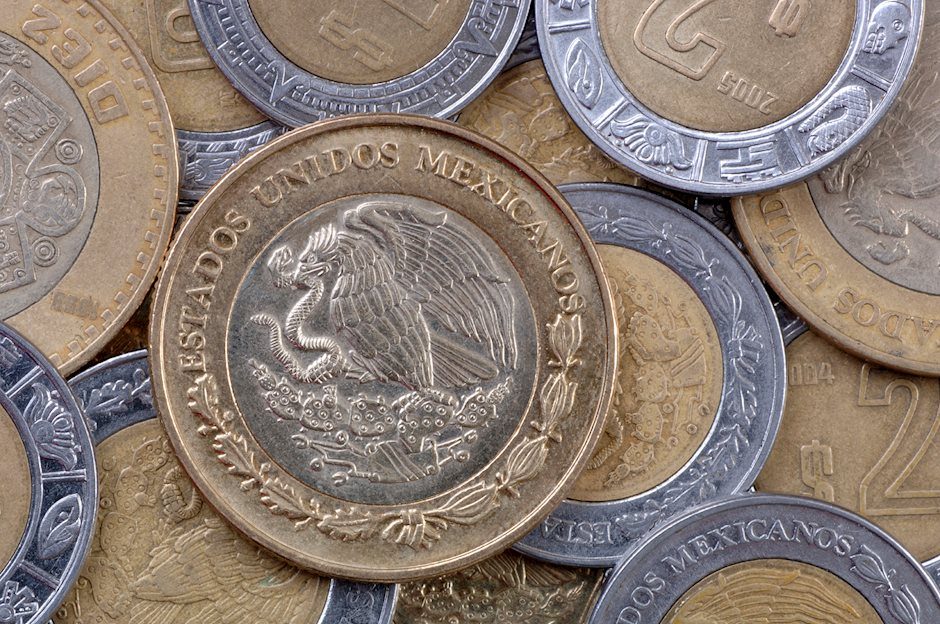Mexican Peso advances steadily on robust economy, unfazed by risks of Middle East conflict
- Mexican Peso extends its gains for the second straight day, as USD/MXN drops to 18.15 despite the sour market mood.
- Mexico's economic activity exceeded estimates in August, providing a positive backdrop for the Peso.
- US 10-year bond yield pulls back from above 5%, weakening the US Dollar.

Mexican Peso (MXN) rallies sharply against the US Dollar (USD) during the mid-North American session, even though the conflict in the Middle East threatens to involve more players, which could trigger a risk-off impulse. That would trigger a flight to safe-haven assets, to the detriment of the Peso. The 10-year bond yield in the United States (US) surpassed the 5% threshold, though it has retreated, weighing on the US Dollar. The USD/MXN is trading at 18.15, down by 0.37% on the day.
Mexico’s economic calendar revealed that economic activity exceeded estimates in August, according to the National Statistics Agency INEGI. The economy grew above estimates in monthly and annually-based figures. The US 10-year bond yield drop from around 5.02% to 4.86% weighed on the Greenback, opening the door for further USD/MXN losses.
Despite recent strength in the emerging market currency, more banks are revising their USD/MXN exchange rate projections upward. Although Citi reviewed Mexico’s Gross Domestic Product (GDP) to 3.3%, analysts estimate the exotic pair would finish the year at around 18.20 for 2023 and 19.40 for 2024, blaming “Next year’s elections in Mexico and the US could result in additional volatility, albeit temporal, in our view.”
Daily Digest Market Movers: Mexican Peso fights back, pushing the pair below 18.20
- The Overall Index of Economic Activity in Mexico grew by 0.4% in August, exceeding the estimated 0.3%.
- Annually based, the Mexican economic activity expanded by 3.7%, smashing forecasts of 3.4%.
- Mexico’s August Retail Sales plunged 0.4% MoM, missing estimates of no change, while annually they expanded by 3.2%. This reading was below forecasts of 4.4% and trailed July’s 5.1% growth.
- Earlier this month, data showed Mexico’s Consumer Price Index (CPI) grew by 4.45% YoY in September, slightly below the 4.47% estimated.
- The core CPI inflation in Mexico stood at a stickier 5.76% YoY, as widely estimated, but has broken below the 6.00% threshold.
- The Bank of Mexico (Banxico) held rates at 11.25% in September and revised its inflation projections from 3.50% to 3.87% for 2024, above the central bank’s 3.00% target (plus or minus 1%).
Technical Analysis: Mexican Peso gathers momentum while USD/MXN buyers anticipate a pullback
The USD/MXN is upward biased, though the ongoing rally was capped short of testing the latest cycle high, the October 6 peak of 18.48, which gave way to a pullback to current exchange rates below the 18.15 area. The pair could aim toward 18.00 before testing the 20-day Simple Moving Average (SMA) at 17.95. A drop below that level could put the uptrend at risk, as the bulls’ latest line of defense is likely to be the 200-day SMA at 17.73.
On the other hand, if the pair aims higher and buyers reclaim 18.48, that would put the 18.50 figure into play, followed by the 19.00 mark.
Banxico FAQs
What is the Bank of Mexico?
The Bank of Mexico, also known as Banxico, is the country’s central bank. Its mission is to preserve the value of Mexico’s currency, the Mexican Peso (MXN), and to set the monetary policy. To this end, its main objective is to maintain low and stable inflation within target levels – at or close to its target of 3%, the midpoint in a tolerance band of between 2% and 4%.
How does the Bank of Mexico’s monetary policy influence the Mexican Peso?
The main tool of the Banxico to guide monetary policy is by setting interest rates. When inflation is above target, the bank will attempt to tame it by raising rates, making it more expensive for households and businesses to borrow money and thus cooling the economy. Higher interest rates are generally positive for the Mexican Peso (MXN) as they lead to higher yields, making the country a more attractive place for investors. On the contrary, lower interest rates tend to weaken MXN. The rate differential with the USD, or how the Banxico is expected to set interest rates compared with the US Federal Reserve (Fed), is a key factor.
How often does the Bank of Mexico meet during the year?
Banxico meets eight times a year, and its monetary policy is greatly influenced by decisions of the US Federal Reserve (Fed). Therefore, the central bank’s decision-making committee usually gathers a week after the Fed. In doing so, Banxico reacts and sometimes anticipates monetary policy measures set by the Federal Reserve. For example, after the Covid-19 pandemic, before the Fed raised rates, Banxico did it first in an attempt to diminish the chances of a substantial depreciation of the Mexican Peso (MXN) and to prevent capital outflows that could destabilize the country.
Author

Christian Borjon Valencia
FXStreet
Christian Borjon began his career as a retail trader in 2010, mainly focused on technical analysis and strategies around it. He started as a swing trader, as he used to work in another industry unrelated to the financial markets.

















